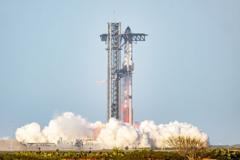SpaceX's founder Elon Musk has confirmed that the company’s Starship rocket is primed for a Mars mission by the end of 2024, contingent upon resolving issues from several explosive test flights. Musk shared his timeline through a post on his social media platform X, indicating that human missions could commence as early as 2029, though he deemed 2031 a more plausible target.
The Starship, which stands as the largest rocket ever built at 123 meters, plays a pivotal role in Musk’s plans to establish a human presence on Mars. However, the rocket's journey has been marred by technical difficulties, including a recent incident where the craft exploded shortly after its departure from Texas, marking the second mishap of the year.
Following the explosion, debris was reported raining down over the Bahamas. SpaceX has stated that it will meticulously analyze data to uncover the causes of these failures, particularly focusing on incidents where multiple engines were lost during flight. The Federal Aviation Administration (FAA) has mandated that SpaceX conduct a thorough investigation before any future launches.
Additionally, NASA has expressed interest in utilizing a modified variant of the Starship for its Artemis missions aimed at returning humans to the Moon. Musk's grand vision encompasses using the Starship system to facilitate human travel between the Moon and Mars, championing a future where humanity becomes a multi-planetary species.
Claims further solidify with Musk announcing that the initial Mars mission will include Tesla’s humanoid robot, "Optimus", a prototype revealed last year. He envisions a future where this robot will undertake routine tasks and will be available to consumers at a cost ranging between $20,000 and $30,000.
In a recent successful endeavor, SpaceX launched its Falcon 9 rocket to take a crew to the International Space Station (ISS), helping to bring astronauts Butch Wilmore and Suni Williams back to Earth after an extended stay of over nine months due to technical complications with their Boeing-built spacecraft.





















